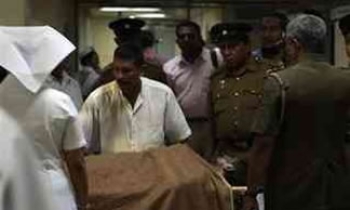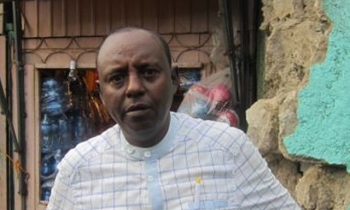BILOXI, Miss., April 8 – Glenn Currie, an architect, slid 50 cents into a coin box here the other morning and pulled out a copy of The Sun Herald, the local daily published in nearby Gulfport.
"I read it every day," he said. "They report what we need to know."
Mr. Currie, 59, said he especially appreciated the paper's before-and-after series, which features a building before Hurricane Katrina struck seven months ago, and after, often to shocking effect.
Less than 80 miles west in New Orleans, a similarly intense reader interest is taking place. At CC's coffeehouse on Magazine Street one morning last week, there were so many people absorbed in that day's Times-Picayune that the scene looked like a commuter train.
"These writers are energized and passionate," said Angele Thionville, 34, a mother of three boys, as she glanced up from the paper. She was not a big fan of The Times-Picayune before Katrina, she said, but now if she misses the paper one day, "I feel so out of touch."
While much of the country has moved on from coverage of Katrina, considered the largest natural disaster in modern American history, both The Sun Herald and The Times-Picayune remain all Katrina, all the time. For their role in covering and enduring the storm, both papers have received accolades, and next week both may well receive Pulitzer Prizes.
Both papers have struggled along with their communities, and during the recovery have faced some similar issues and adopted similar approaches to their new reality. But there are major differences, too. Both have taken on a new importance as news sources and as advocates in their communities. With buildings along 70 miles of the Gulf Coast reduced to matchsticks and parts of New Orleans abandoned and still without reliable electricity or phone service, The Sun Herald and Times-Picayune are connecting with readers the way newspapers did before the arrival of television.
The big question, ultimately tied to the economic fortunes of their areas, is what kind of future these newspapers will have as news organizations and businesses. Here their stories diverge. The Sun Herald, which before the storm had a circulation of 47,000 daily and 55,000 on Sunday, has rebuilt its circulation and advertising base; it is just 400 shy of its prestorm circulation and a few percentage points short of its prestorm ad revenue.
Even as many homes and buildings remain skeletal or in mounds of debris, the presence of casinos here and the likelihood that more will come has instilled confidence in the region.
The Times-Picayune, which had more than five times the circulation of The Sun Herald, now has regained about two-thirds of its readers, with a circulation of 176,000 daily and 196,000 on Sunday. But readers are returning faster than advertisers. Only 10 percent of the city's businesses have reopened. "We're suffering significant revenue losses," said Ashton Phelps Jr., publisher of the newspaper, which is owned by Advance Publications.
The obstacles that New Orleans and its newspaper faced in the storm and continue to face are on a different order of magnitude from the Gulf Coast as a whole. More than 200 people died in Mississippi, and 300 are still missing. In New Orleans, more than 1,100 died, and 2,000 are missing.
New Orleans faces bigger challenges, too, in part because of its terrain. The water remained in New Orleans, while it quickly drained from other communities along the coast. New Orleans is scrambling to reinforce the levees as the next hurricane season approaches, and residents are still waiting for flood maps before they decide whether to rebuild, leaving a cloud of uncertainty over the city. It is also in the midst of a chaotic mayor's race with two dozen candidates, making its leadership seem unstable and its direction unclear.
The tiny Sun Herald, indeed much of the Gulf Coast, has been overshadowed by the attention paid to New Orleans. But recognition may be at hand. Editor & Publisher, which reports on the newspaper business, said last month that The Sun Herald was in line to receive the Pulitzer Prize for public service.
The Times-Picayune, according to Editor & Publisher, is a Pulitzer finalist in two categories: commentary (by Chris Rose, one of its columnists) and breaking news, for reporting that a major levee had been breached and the city was being flooded while other media were reporting that New Orleans had been spared.
The Pulitzer board, which does not comment on finalists at this stage of the process, is meeting in New York later in the week to vote on the winners, and is to announce them next Monday.
The report that The Sun Herald may be under consideration for the public service award, journalism's highest honor, has already been something of a victory for the paper – and something of a disappointment for The Times-Picayune, stoking a newfound competition between the two. The Sun Herald likes to emphasize that it did not miss a day of print publication, while The Times-Picayune points to the scope of the disaster in New Orleans and its near-impossible reporting conditions.
The Pulitzer board can move finalists to different categories, so no one can say if either paper will make the cut or in which category. But the head-to-head competition over Katrina coverage suggests that the board will have to grapple with the very definition of public service.
The spotlight on New Orleans after Katrina has been a sore point for Mississippi. The Sun Herald has editorialized to that effect, complaining that the national media had left the broader Gulf Coast a footnote in the New Orleans story.
Before the storm, The Sun Herald, which is owned by Knight Ridder, had an emergency plan in place. The paper, in advance, sent four of its news staff members and two Knight Ridder designers to its sister paper, The Ledger-Enquirer in Columbus, Ga., while most of the staff reported along the coast and hunkered down in the Sun Herald building.
The building was built after Hurricane Camille destroyed the region in 1969. It sustained little damage from Katrina, and its presses remained dry, but it lost all power and communications. Shortly, the Knight Ridder cavalry arrived in Gulfport.
"They showed up with sat phones, chain saws, food and water," said Stan Tiner, The Sun Herald's editor and a former marine. "The logistics were very well organized." Even P. Anthony Ridder, the company's chief executive, showed up.
The Times-Picayune staff evacuated its building in delivery trucks as the floodwaters rose, and headed to Baton Rouge, La. A small band of reporters and editors felt sick at the thought of leaving and commandeered a delivery truck to return to New Orleans, defying martial law to report the news. The Times-Picayune suspended publication for three days.
Staff members at both papers experienced much of the grief that their readers did, but while many lost their houses, no employees died. Some lost loved ones, and all have their own harrowing tales.
Jean Prescott, 64, a features writer at The Sun Herald, said that her sister and her sister's husband drowned in their house. The authorities subsequently misplaced the bodies, she said, then they cremated someone else instead of her sister. The family did not receive her sister's ashes for three months.
"It wasn't unique," Ms. Prescott said. "So many people were found dead, they just couldn't keep track."
Workers at both papers said they are throwing themselves into telling their readers' stories instead of coping with their own.
"We're journalists and we just pack it away," said James O'Byrne, 46, features editor of The Times-Picayune, whose home was ruined. "You don't get a special badge of courage for losing your home," he said; it was a common event.
Anita Lee, 49, a reporter at The Sun Herald, said, "We're just not dealing with a lot of it," as she stepped around the debris of her former home and showed off the government-issued trailer where she lives now. "Our insurance is up in the air, our S.B.A. loan is not finalized, our house has not been torn down, and we're writing about other people in the same situation."
In some ways, she said, the shared experience with her readers has made her job easier. "I always tried to get to a level of understanding with the people I was interviewing," she said. "Now I get there a lot quicker."
The experience has given the pages of both papers a new urgency, and both seem less constrained by traditional objectivity, to the point of printing front-page editorials.
"We're far more direct in getting at what we think matters," said Jim Amoss, the editor of The Times-Picayune. "The urgency is palpable."
Mike Perlstein, 45, a criminal justice reporter at The Times-Picayune, said that articles about underhanded dealings and "good-old-boy New Orleans ways of doing things" that once drew ho-hum reactions are now "drawing howls of outrage from readers and keeping the news staff really engaged."
"There are issues on the business side, as there are with any newspaper," he added. "But we're still riding a riveting and unbelievable story about the rebuilding of a major American city."
Part of that rebuilding for the city and the paper depends on the return of advertisers. "It's a chicken-and-egg thing," said Tod Smith, who directs advertising plans for major clients in New Orleans. "What comes first, the services that people need? Or the people who support the services? There are a lot of unanswered questions."
The paper has many ads for car dealers (many people had car insurance, so practically all cars in New Orleans look brand new). The paper also is running small ads for services like mold remediation and air-duct cleaning. And its big department store, Dillard's, is open and buying full-page ads.
On the Gulf Coast, Dillard's remains shuttered. But Vicki Barrett, the advertising director at The Sun Herald, said that what the paper had lost in retail advertising, it had gained in classified ads. Perhaps one measure of the comeback status of both regions is an ad in The Sun Herald that would seem unthinkable in New Orleans – a company promising to meet "all your swimming pool needs."
The Sun Herald is optimistic about its future. South Mississippi, with its miles of white sandy beachfront and new casinos being built inland, expects more than $30 billion in new investment in the next few years.
"It's going to be a boom like no newspaper market has ever seen," said Ricky R. Mathews, The Sun Herald's publisher.
Gary Pruitt, the chief executive of McClatchy, which recently agreed to buy Knight Ridder, agrees. Mr. Pruitt is selling 12 of Knight Ridder's 32 papers, but he is keeping The Sun Herald, saying it meets his criteria for a growth market.
"We're basing our decision on our readings of the business and population projections and the resiliency of the local economy," he said.
Mr. Phelps, of The Times-Picayune, addressed the matter at a meeting of newspaper executives recently.
"The $64,000 question for us is this: What is the economy going to look like 18 months, two years from now, when most of the insurance checks have been cashed and the federal relief efforts taper off?" Mr. Phelps asked.
"We just don't know," he said, adding later: "The truth is that it's so big, we have still not found the bottom of how life has changed for us. We're still riding Katrina's winds."









